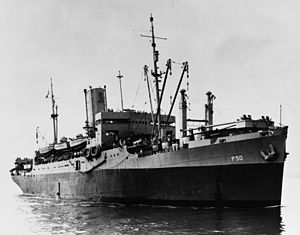
USS Susan B. Anthony (AP-72) was a turbo-electric ocean liner, Santa Clara, of the Grace Steamship Company that was built in 1930. Santa Clara was turned over to the War Shipping Administration (WSA) on 28 February 1942 and operated by Grace Lines as agent for WSA as a troop ship making voyages to the South Pacific. The ship was chartered to the Navy on 7 August 1942 for operation as a United States Navy transport ship. The ship was sunk 7 June 1944 off Normandy by a mine while cruising through a swept channel with all 2,689 people aboard being saved.

A troopship is a ship used to carry soldiers, either in peacetime or wartime. Troopships were often drafted from commercial shipping fleets, and were unable to land troops directly on shore, typically loading and unloading at a seaport or onto smaller vessels, either tenders or barges.
The 4 Aces were the quartet of passenger-cargo liners Excalibur, Exochorda, Exeter, and Excambion, originally built for American Export Lines by New York Shipbuilding of Camden, New Jersey between 1929 and 1931. AEL placed the "4 Aces" in service between the US and the Mediterranean, offering cruises of up to 40 days.

USS Arthur Middleton (AP-55/APA-25) was the lead ship of the Arthur Middleton-class attack transports and was in service with the United States Navy from 1942 to 1946. She was named for Founding Father Arthur Middleton and was scrapped in 1973.

Attack transport is a United States Navy ship classification for a variant of ocean-going troopship adapted to transporting invasion forces ashore. Unlike standard troopships – often drafted from the merchant fleet – that rely on either a quay or tenders, attack transports carry their own fleet of landing craft, such as the landing craft, vehicle, personnel (LCVP) or Higgins boat.

USS Miantonomah (CM-10/CMc-5) was built as SS Quaker by Pusey & Jones Corporation, Wilmington, Delaware in 1938 as a commercial coastwise ship operating as a fast inland water passenger and freight carrier. Quaker was acquired by the Navy in May 1941 for conversion to a coastal minelayer. Miantonomah operated off the east coast of the United States, Africa and the Mediterranean and took part in the invasion of Europe in 1944. The ship was sunk by a mine 25 September 1944.
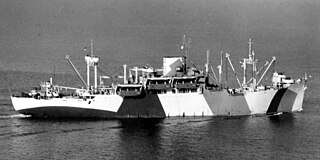
USS Thomas Jefferson (APA-30), serving from 1 May 1942 until 18 July 1955, was a transport and then reclassified on 1 February 1943 as a President Jackson-class attack transport. She was laid down under Maritime Commission contract as President Garfield on 5 February 1940 at Newport News, Virginia, by the Newport News Shipbuilding & Drydock Company for the American President Lines. The ship was launched on 20 November 1940, sponsored by Miss Eugenia Merrill. President Garfield was completed 26 March 1941 and acquired by the War Shipping Administration (WSA) 29 November 1941 with American President Lines, the WSA agent, operating the ship as a troop transport. On 1 May 1942 the United States Navy purchased the ship and commissioned her USS Thomas Jefferson, named for Founding Father Thomas Jefferson, on 31 August 1942.

USS Hugh L. Scott (AP-43) was a Hugh L. Scott-class transport ship. She was built in 1921 and spent 20 years in merchant service as a passenger and cargo liner. In July 1941 the ship was delivered to the United States Department of War for Army service as the United States Army Transport Hugh L. Scott operating in the Pacific. In August 1942 the ship was transferred to the United States Navy for conversion to an attack transport, served as a troopship in Operation Torch in November 1942, and was sunk by a U-boat four days later. 59 crewmen and soldiers died during the sinking.
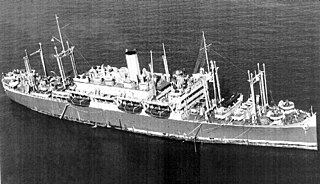
SS President Cleveland was originally built as Golden State for the United States Shipping Board (USSB), one of the planned World War I troop transports converted before construction into passenger and cargo vessels launched as Emergency Fleet Corporation Design 1029 ships first known, along with the smaller Design 1095 versions, in the trade as "State" ships due to names assigned for the nicknames of states and later as "535s" for their length overall. Almost all ships of both designs were renamed for United States presidents by May 1921, with Golden State being renamed President Cleveland. As one of the USSB-owned ships operated by agents of the board, President Cleveland was allocated to and operated by the Pacific Mail Steamship Company until sold by the USSB to the Dollar Steamship Line in 1925. After the demise of that line and creation of a new, replacement line, American President Lines, the ship remained with that line until government acquisition for the Second World War.
USS Edward Rutledge (AP-52/APA-24) was an Edward Rutledge-class troop transport (AP), later re-designated as an attack transport (APA). She was acquired by the U.S. Navy for use in World War II, and was assigned the task of transporting troops to and from battle areas. Operating in dangerous Mediterranean waters on 12 November 1942, she was sunk after being struck by a German submarine’s torpedo at Fedala Bay, Morocco.

USS Harry Lee (APA-10) was a Harry Lee-class attack transport that saw service with the US Navy during World War II. She served in the Pacific War, as well as in North Atlantic Ocean operations, and safely returned home post-war with seven battle stars to her credit. She was the only ship in her class.

USS Clay (APA-39) was a Bayfield class attack transport in service with the United States Navy from 1943 to 1946. She was then sold into commercial service and was scrapped in 1974.

USS General T. H. Bliss (AP-131) was a General G. O. Squier-class transport ship for the U.S. Navy in World War II. She was named in honor of U.S. Army general Tasker Howard Bliss. Decommissioned in 1946, she was sold privately in 1964 and renamed SS Seamar, and was scrapped in 1979.

USS John Penn (APA-23) was an attack transport that served with the US Navy during World War II. Named after Founding Father John Penn, a signatory to the American Declaration of Independence, she was the only ship in her class.

The Windsor-class attack transport was a class of nine US Navy attack transports. Ships of the class saw service in World War II.

USS Leonard Wood (APA-12) was built by Bethlehem Shipbuilding Corporation and launched 17 September 1921 at Sparrows Point, Maryland as Nutmeg State, an Emergency Fleet Corporation Design 1029 ship intended as a World War I troop transport, but redesigned upon the armistice as a passenger and cargo ship and completed as Western World for delivery to the United States Shipping Board. The ship's acceptance on 5 May 1922 and delivery on 9 May 1922 marked the completion of the wartime shipbuilding program of the Emergency Fleet Corporation and the Shipping Board.
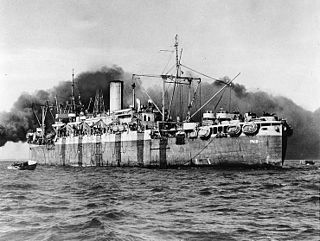
SS President Roosevelt was an ocean liner in service in the 1920s and 1930s. Originally built as a Harris-class attack transport towards the end of World War I, she entered commercial service after her completion. Having been built as Peninsula State, she was soon renamed President Pierce and then President Roosevelt. Requisitioned for service as a troopship with the US Navy during World War II, she was renamed USS Joseph T. Dickman (APA-13) and served in the Atlantic and Pacific theaters, being scrapped postwar in 1948.

SS Exochorda was a 473-foot, 14,500-ton cargo liner in service with American Export Lines from 1948 to 1959. A member of the line's post-war quartet of ships, "4 Aces", Exochorda sailed regularly from New York on a Mediterranean route. Originally built in 1944 as the military attack transport USS Dauphin (APA-97), the ship was extensively refurbished prior to her service as a passenger-cargo liner. Following her service as a cruise liner, the vessel served as the floating dormitory ship SS Stevens for the students of Stevens Institute of Technology, a technological university, in Hoboken, NJ. At the end of her service life she was scrapped, in 1979.
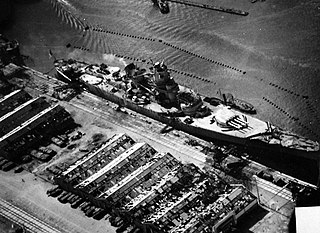
The Naval Battle of Casablanca was a series of naval engagements fought between American ships covering the invasion of North Africa and Vichy French ships defending the neutrality of French Morocco in accordance with the Second Armistice at Compiègne during World War II.
